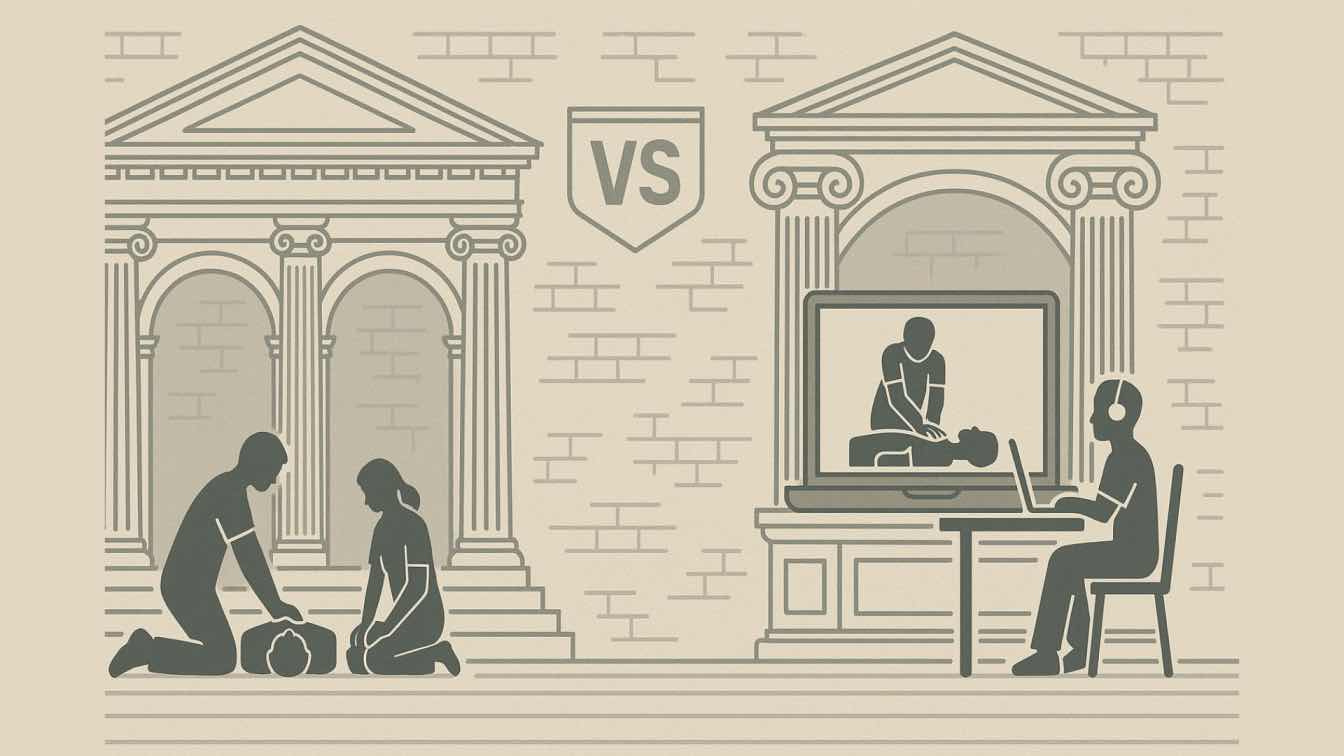You’re halfway through a shift when a Code Blue(a hospital emergency code indicating cardiac arrest patients) hits. You rush in, compressions, airway, defib. No time to think, only act. That kind of confidence? It doesn’t come from just having a card, it comes from keeping your BLS skills updated.
Now the question is: how should you do that? A hands-on BLS skills update feels real and physical, just like an emergency. But a virtual update fits around a tight schedule, offering convenience without the commute.
The need to stay certified hasn’t changed. But the way you do it has. Scroll down to explore both options, what they offer, who they’re best for, and how to choose the one that keeps you sharp without disrupting your life.
What is the Two BLS Skills Update Option
Every year, around 275,000 people in Europe suffer cardiac arrest outside of hospitals. That’s nearly 750 people a day. In these moments, the outcome often depends on whether someone nearby knows how to respond. That’s why keeping your BLS skills current is a real-world responsibility. Also, it's helpful to understand what each format offers before choosing the best way.
Hands-On BLS Skills Update
In this format, you show up in a real classroom. You work with manikins, use actual equipment, and get guided step by step by a trainer. The benefit? You feel what it’s like to perform CPR, use a defibrillator, and manage airways in a real setting. And at the end, you go through a short assessment to renew your certification.
Virtual BLS Skills Update
This option lets you learn from anywhere, at home, during a break, or even after your shift. You go through videos, interactive lessons, and step-by-step instructions online. Some courses are fully remote, while others include a short hands-on session at the end to check your skills in person.
Both options meet official certification standards. The main difference is how you get there, and which one fits your schedule and learning style better.
Hands-On vs Virtual BLS Skills Update – What’s the Difference?
To help you understand what each option really involves, here’s a quick side-by-side comparison:
|
Feature |
Hands-On BLS Update |
Virtual BLS Update |
|
Learning Format |
In-person training with a live instructor and equipment |
Online modules, videos, and interactive content |
|
Location |
Training center or on-site classroom |
Anywhere with internet access |
|
Schedule Flexibility |
Fixed dates and times |
Fully flexible and self-paced |
|
Skill Practice |
Real-time practice on manikins and devices |
Limited practice; some include an in-person skill check |
|
Instructor Feedback |
Immediate, face-to-face guidance |
Online support; feedback may be delayed or optional |
|
Best For |
Learners who prefer hands-on experience and structure |
Busy professionals needing flexibility and convenience |
|
Time Commitment |
Usually completed in one in-person session |
Spread over several shorter sessions, at your own pace |
|
Technology Needed |
None beyond class materials |
A device with an internet connection |
|
Certification Validity |
Fully recognized |
Fully recognized (if from an accredited provider) |
Benefits of Hands-On BLS Skills Update
Hands-on training is the classic way to update your BLS skills. It lets you physically practice life-saving techniques, which can make a big difference in how confident and prepared you feel. The following are some of the key benefits of choosing hands-on training:
1. Real Practice Builds Confidence
Hands-on training lets you physically practice life-saving techniques. Using manikins and real equipment helps build muscle memory, so in an emergency, your actions come naturally.
2. Immediate Feedback Helps You Improve
Having an instructor right there means you get quick corrections. This live guidance helps you learn faster and avoid mistakes when it really counts.
3. Learn Through Interaction
Being in a classroom with peers and trainers gives you chances to ask questions, watch demonstrations, and discuss challenges. This interaction deepens your understanding and keeps you engaged.
4. Feel Ready to Act
Many learners say that practicing hands-on makes them feel more prepared and confident to respond in real situations.
Benefits of Virtual BLS Skills Update
Virtual BLS skills updates have grown popular because they fit easily into busy lives. They allow you to learn important life-saving techniques without being tied to a specific location or schedule. Here are some key benefits of virtual training:
1. Learn at Your Own Pace
Virtual courses let you study whenever it works best for you. Whether it’s during a lunch break or late at night, you can move through the material at a speed that suits your learning style.
2. Flexible Access from Anywhere
As long as you have an internet connection, you can access your training from home, work, or on the go. This makes it ideal for those with unpredictable or demanding schedules.
3. Cost and Time Efficient
Virtual courses often save time and money by eliminating the need to travel to a training center. Plus, many are designed to be completed in shorter, manageable segments.
4. Blend of Online and In-Person
Many virtual programs offer a blended approach, combining online learning with a brief hands-on session to practice key skills and receive feedback.
5. Stay Updated with the Latest Science
Online platforms are quick to update, so you always learn the most current guidelines and techniques.
What Learners Say: Who Prefers What?
Different people have different learning styles and schedules, which affect their choice between hands-on and virtual BLS skills updates. The following points highlight who tends to benefit most from each approach:
Hands-On Learners
Many prefer hands-on training because they like practicing physically and getting immediate feedback. They feel this approach builds confidence and helps them remember skills better. It’s also great for those who enjoy interacting directly with instructors and peers.
Virtual Learners
Others choose virtual training for its convenience and flexibility. Busy professionals, parents, or those with unpredictable schedules appreciate being able to study at their own pace and avoid travel time. Virtual formats also appeal to tech-savvy learners comfortable with online platforms.
Blended Approach Learners
Some find the best of both worlds in blended courses, which combine online learning with a short in-person session. This gives them flexibility while still allowing for hands-on practice and instructor guidance.
Understanding your own preferences and needs will help you pick the right format to maintain your BLS skills effectively.
What Research Says About Hands-On vs Virtual BLS Training
Recent studies show that both hands-on and virtual BLS skills updates improve knowledge and skills. However, hands-on mannequin-based training stands out when it comes to mastering critical techniques like correct chest compression depth and rate, according to Journal of Education and Health Promotion. In one study with medical students, those trained on mannequins performed significantly better in real-life CPR skills compared to students who only did online training.
Another study published in Environmental Research and Public Health comparing virtual reality (VR) BLS training with traditional methods found that both approaches increased skills initially, but traditional hands-on practice resulted in better performance in defibrillation skills and skill retention over time.
The key takeaway? Both methods are effective. Hands-on sessions may boost physical skill accuracy, while online formats offer unmatched flexibility and access, making them ideal for busy professionals. Choosing the right format depends on your needs, learning style, and schedule.
Choose What Fits, Stay Ready Always
Whether you go hands-on, virtual, or blended, updating your BLS skills is about staying prepared, on your terms. Both formats offer effective ways to refresh knowledge and build confidence, without disrupting your routine.
What matters most is making the choice that works for you, because readiness should never wait. Choose an online BLS skills update that fits your routine and keeps you ready to act, anytime, anywhere.





